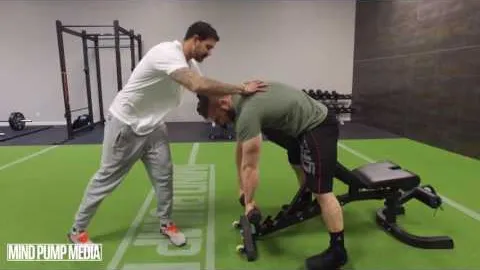
If you're looking to strengthen and tone your shoulders, incorporating the rear delt fly exercise into your fitness routine is a great option. The rear delt fly primarily targets the posterior deltoid muscle, which is responsible for the backward movement of the shoulder joint. It also engages other supporting muscles such as the trapezius, rhomboids, and rotator cuff.
Starting Position: Begin by standing with your feet shoulder-width apart. Hold a dumbbell in each hand, with your palms facing inward towards your body. Bend your knees slightly and hinge forward from your hips, maintaining a neutral spine. Ensure your arms are fully extended towards the floor.
Execution: While keeping your core engaged and your elbows slightly bent, exhale and lift your arms outward and upward, leading with your elbows. Continue the movement until your arms are in line with your shoulders. Hold the contraction for a brief moment, then slowly lower your arms back down to the starting position.
Breathing: Inhale during the eccentric (lowering) phase and exhale during the concentric (lifting) phase.
Repetitions: Aim for 3 sets of 10-15 repetitions, gradually increasing weight as you build strength and endurance. Allow a brief rest period between sets.
Maintain proper form throughout the exercise by keeping your back straight and your core engaged. Avoid rounding your shoulders or arching your back.
Start with light weights and gradually increase the load as your muscles adapt. Proper form and technique should always take precedence over the amount of weight lifted.
Control the movement and avoid using momentum to perform the exercise. This will ensure that you're effectively targeting the intended muscles.
If you experience any pain or discomfort during the exercise, stop immediately and consult with a qualified fitness professional or healthcare provider.
Strengthening and Toning: The rear delt fly exercise targets and strengthens the posterior deltoid muscle, which helps improve overall shoulder stability and posture. Strong rear delts can also enhance your physique by giving your shoulders a rounder, more defined appearance.
Improves Posture: Many individuals experience poor posture due to excessive sitting and forward shoulder slouching. By strengthening the muscles of the upper back, including the rear delts, you can counteract the effects of prolonged sitting and contribute to better postural alignment.
Prevents Shoulder Imbalances: Regularly incorporating the rear delt fly exercise into your routine can help prevent muscle imbalances between the anterior (front) and posterior (back) shoulder muscles. By promoting balanced strength, you can reduce the risk of shoulder injuries and enhance overall shoulder joint stability.
Enhances Shoulder Functionality: Strong rear delts play a crucial role in various daily activities and sports movements, such as pulling, rowing, and throwing. By targeting this muscle group, you can improve performance in these activities and reduce the risk of shoulder-related injuries.
Resistance Band Rear Delt Fly: Attach a resistance band to a fixed object at chest height. Grasp the band handles and step back to create tension. Perform the rear delt fly motion as described earlier, with the band providing resistance throughout the movement.
Reverse Pec Deck Fly: Use a pec deck machine with the chest pad set at a slightly higher position than usual. Sit facing the machine, grasp the handles with an overhand grip, and perform the rear delt fly movement by squeezing your shoulder blades together. This machine provides constant resistance throughout the movement.
Bent-Over Dumbbell Reverse Fly: Stand with your feet shoulder-width apart and hold a dumbbell in each hand. Bend your knees slightly and hinge forward from your hips, maintaining a neutral spine. With your arms fully extended towards the floor, lift your arms outward and upward, leading with your elbows. Hold the contraction for a brief moment, then slowly lower your arms back down to the starting position.
The rear delt fly exercise is an effective way to strengthen and tone your shoulders, particularly targeting the posterior deltoid muscle. By incorporating this exercise into your fitness routine, you can improve shoulder stability, enhance posture, prevent muscle imbalances, and enhance overall shoulder functionality. Remember to start with lighter weights, maintain proper form, and gradually increase the load as your muscles adapt. As always, consult with a qualified fitness professional or healthcare provider if you have any concerns or questions regarding your exercise regimen. Start reaping the benefits of the rear delt fly and unlock your shoulder's full potential!
If you're looking for a gym, fitness club or yoga studio, you've come to the right place.
You can find information about gyms in your area. Browse catalog of gyms and find gyms with classes which are you looking for.
On gym page you can find simple information like address, phone or website. You can find list of available classes. You can check availability of personal training or small group classes. On place page you can also see information about open hours.
You can find gyms near you with amenities, courts, studios and equipments.
Use our map to find gym at your city or district.
In Gym Navigator you can find list of exercises with movies for many body parts.
You can browse exercises catalog and find exercises the best of you.
You can also find exercises grouped into workout plans, which you can use to improve you body. Each routine show you exercises one by one and give you possibility to count you progress and count down rest time.